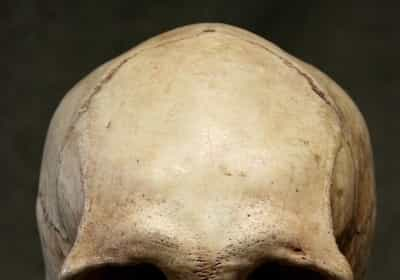Complete and, in all probability, early overgrowth sagittal suture (sutura sagittalis) and the left half of the coronal suture (sutura coronalis). Preserved and continued to function only the right half of the coronal suture and not overgrown frontal suture (sutura frontalis). The normal growth of the edges of just the right half of the frontal bone and the sides of the adjacent bones led to a sharp deformation of the anterior part of the cerebral skull.
Types of Skull Ridges
Premature overgrowth of only one sagittal suture usually increases the skull; the width turns out to be significantly limited. At the same time, the activity of the coronal and lambdoid sutures continues and the skull grows in the longitudinal direction. As a result, deformation occurs, known as scaphocephaly. Brain skull, in this case, is long and narrow and resembles a boat, turned keel up.

An exciting group of deformities of the human skull is deformities caused by a premature overgrowth of certain seams.
In cases where one of the seams is overgrown, and rising edges of the bones here is terminated, while the other joints continue to function, there is a violation of the harmonious growth of the skull as a whole. This naturally leads to its General deformation.
What causes premature fusion of some bones of the skull is unknown. It is possible that this phenomenon is associated with some violation of the normal function of one of the endocrine glands. However, it should be recognized that there has not yet been a single fact that would indicate the existence of a link between the overgrowth of seams and the activity of any of the endocrine glands.
Sometimes the early overgrowth is exposed not one, but several seams. This also leads to deformation of the skull.
In those cases, when prematurely closed sutures such as coronal and sagittal, the small size of the upper section of the skull of the child are recorded, and their increase ceases. Since the growth of bones in the remaining sutures of the skull continues, the adult has a so-called “tower” head. The brain skull becomes elongated upwards and slightly backward.
How Are Skull Ridges Developed
It is where the tendons are anchoring. Each time you tense the muscle, the tendon gets pulled. In some individuals during their early development, they worked out those muscles to the extend that the tendon achor (enthesis) pulled the skin of the bone (periosteum). This develops a space where bone turns into– and therefore the ridge.
A side note. Working out the body parts below the neck tends to make a person look more youthful. Exercising the body parts above the neck tends to make a person look older — when they are young it can cause bone growth as ridges, and when older, it causes wrinkles, and ultimately wrinkle scars.
About the Author
Reyus Mammadli is the author of this health blog since 2008. With a background in medical and biotechnical devices, he has over 15 years of experience working with medical literature and expert guidelines from WHO, CDC, Mayo Clinic, and others. His goal is to present clear, accurate health information for everyday readers — not as a substitute for medical advice.







Basically your skull size is fairly consistent throughout your adult and teenage years, from 15-20 years on, nevertheless aside from your posterior cranial area, the facial bones can undergo quite a considerable change as according to age and medical conditions. The majority of appropriately your skin shows essential age associated changes which increase from the age of 25 concurrent with the slow down and eventual non performance of your growth hormone center.
Your facial bones may undergo age-related osteoporosis decreasing density to bone cellular structure and therefore becoming less resistant to external conditions in addition to the impact of personal health stability, much influenced by nutrition and excercise as well as air-borne and water borne contaminants. A range of conditions impact the facial structure, from restricted blood flow and stroke conditions to the method we sleep and sustain our posture. Toxic substances can reduce the pliable texture of look and a multitude of syndromes can trigger little to medium imprints and bumps on the head consisting of more significant diseases and health problems which can transform an individuals appearance from bone conditions caused by pressure from internal growths, to infections and bacterial super-bugs. The facial structure of the skull includes the mandible, Maxillary, Zygomatic, and Frontal Bones while the sides such as where your temples are include the Temporal and Sphenoid Bones. While the cartilage of the nasal passage is inside the nose, the septum can be severely distorted and literally destroyed by drug use and unexpected trauma.
In stating this, natural conditions show us that bone structure and appearance have an unlimited variety of beauty and uniqueness, no matter how various one is from your appearance, there is charm continual within and on your outside, Both physiological balance along with psychological health are essential signs as well as the root cause of skull shape. A rather essential area of your face that has tremendous effect on your skull shape is your teeth. Good healthy teeth are among the basics of good living. Diseases such as tooch decay and gum conditions can distort look and not having correct oral care can trigger your jawline to appear abnormally connected from side-ward growing wisdom teeth and more.
While aging is a significant factor to facial structure, good nutrition and avoiding sugar associated consumption can make a positive difference in your convenience and overall health along with decrease oxidation while preserving healthy muscle and bone.